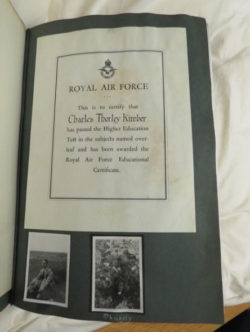Scrapbooks are a bridge between different forms of life writing – functioning sometimes as a diary, photo album, autobiography, and broader archive. Scrapbooks often contain a range of material, including newspaper clippings, photographs, letters, pressed flowers, money, and other objects.
Take a scrapbook in our collections made by Charles Kimber. Kimber joined the Royal Air Force in 1928 and worked his way up from aircraft apprentice to the senior rank of Wing Commander in 1944-45. He retired from the RAF in 1957 and when he wasn’t teaching in a secondary school, he wrote Son of Halton The Memoirs of an Ex-Brat (1977).
After writing his memoir, he commented on what he called operation ‘clean-up’ to take back control of his home which became filled with ‘unwanted papers, memos and files’. What was ‘cleaned up’ found its way into a scrapbook.
Unusually, Kimber reflects on the process of compiling the scrapbook, noting that the different sized items made it impossible to keep to a chronological order. Despite this quirky ordering, the pages of Kimber’s 14lb scrapbook offer readers a window into the nature of Kimber’s military service and how he chose to record it. Compiled later in life, we see photographs of Kimber and his RAF colleagues, letters from the Queen and Prime Minister Margaret Thatcher, as well as his receipt of various awards.
What did the material culture of military service entail? What do these material choices suggest about the blurring of civilian and military identities? What do the material choices about selection and arrangement reveal about the ways in which someone documents a life? These are just some of the questions we can ask when leafing through the pages of a scrapbook.

Source: KMBR 1, Churchill Archives Centre.
Find out more about:
- Kimber’s scrapbook at Churchill Archives Centre.
- Kimber’s memoir Son of Halton: The Memoirs of an Ex-Brat (1977)
- Working with scrapbooks as historical sources in this blog published by the Historical Association.
- Other scrapbooks in our collections in this blog on women’s scrapbooks on political and diplomatic activity in the late-nineteenth and early twentieth centuries.
Other scrapbooks in our collections:
- Lady Agnes Cooper’s scrapbook, 1846-1865, DUFC 17/1.
- Lady Spencer Churchill’s albums, 1890-1977, CSCT 5.
- Kathleen Wanstall’s scrapbook containing official documents and ephemera collected during the period 1914-18, mainly from Austria and Germany, MISC 98.
- Selwyn Lloyd’s scrapbook of cuttings and souvenirs, 1924-1925, SELO 3/20.
- Baron Noel-Baker’s Scrapbook of the Olympics, 1928, NBKR 6/1.
- Florence Horsbrugh’s early years as an MP, c.1930s, HSBR 2.
If we’ve whetted your appetite, then do get in touch to explore our collections.
Want to catch up with earlier posts in our series? Check out our blogs on autobiographies and biographies, letters and diaries.
Looking for useful introductions for working with life writing? Here’s some of our favourites:
- Dobson, Miriam, and Benjamin Ziemann, eds. Reading primary sources: the interpretation of texts from nineteenth and twentieth century history. Routledge, 2020.
- Barber, Sarah, and Corinna Peniston-Bird, eds. History beyond the text: a student’s guide to approaching alternative sources. Routledge, 2013.
- Summerfield, Penny. Histories of the self: Personal narratives and historical practice. Routledge, 2018.
- Saunders, Valerie, “Life Writing”. In Victorian Literature, (accessed 4 Aug. 2021).
By Cherish Watton, Archives Assistant.
Subscribe to Churchill Archives Centre News
Enter your email address:
Subscribe to the Churchill Archives News RSS feed:
